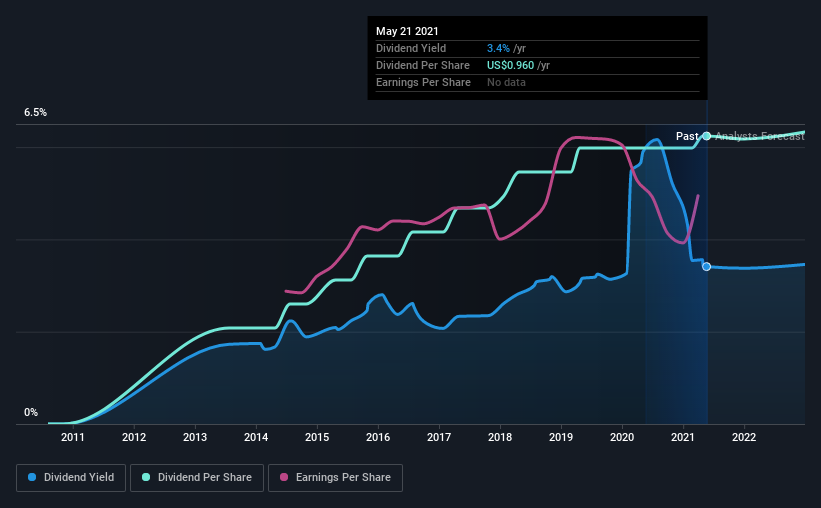Central Pacific Financial Corp. (NYSE:CPF) Goes Ex-Dividend Soon
Regular readers will know that we love our dividends at Simply Wall St, which is why it's exciting to see Central Pacific Financial Corp. (NYSE:CPF) is about to trade ex-dividend in the next 4 days. Typically, the ex-dividend date is one business day before the record date which is the date on which a company determines the shareholders eligible to receive a dividend. The ex-dividend date is of consequence because whenever a stock is bought or sold, the trade takes at least two business day to settle. This means that investors who purchase Central Pacific Financial's shares on or after the 27th of May will not receive the dividend, which will be paid on the 15th of June.
The company's upcoming dividend is US$0.24 a share, following on from the last 12 months, when the company distributed a total of US$0.96 per share to shareholders. Based on the last year's worth of payments, Central Pacific Financial has a trailing yield of 3.4% on the current stock price of $28.15. Dividends are a major contributor to investment returns for long term holders, but only if the dividend continues to be paid. That's why we should always check whether the dividend payments appear sustainable, and if the company is growing.
See our latest analysis for Central Pacific Financial
Dividends are typically paid out of company income, so if a company pays out more than it earned, its dividend is usually at a higher risk of being cut. Central Pacific Financial is paying out an acceptable 55% of its profit, a common payout level among most companies.
When a company paid out less in dividends than it earned in profit, this generally suggests its dividend is affordable. The lower the % of its profit that it pays out, the greater the margin of safety for the dividend if the business enters a downturn.
Click here to see the company's payout ratio, plus analyst estimates of its future dividends.
Have Earnings And Dividends Been Growing?
Businesses with strong growth prospects usually make the best dividend payers, because it's easier to grow dividends when earnings per share are improving. If business enters a downturn and the dividend is cut, the company could see its value fall precipitously. This is why it's a relief to see Central Pacific Financial earnings per share are up 3.3% per annum over the last five years.
Many investors will assess a company's dividend performance by evaluating how much the dividend payments have changed over time. Central Pacific Financial has delivered 15% dividend growth per year on average over the past eight years. We're glad to see dividends rising alongside earnings over a number of years, which may be a sign the company intends to share the growth with shareholders.
The Bottom Line
From a dividend perspective, should investors buy or avoid Central Pacific Financial? Earnings per share have been growing at a reasonable rate, and the company is paying out a bit over half its earnings as dividends. We're unconvinced on the company's merits, and think there might be better opportunities out there.
However if you're still interested in Central Pacific Financial as a potential investment, you should definitely consider some of the risks involved with Central Pacific Financial. We've identified 3 warning signs with Central Pacific Financial (at least 1 which shouldn't be ignored), and understanding them should be part of your investment process.
A common investment mistake is buying the first interesting stock you see. Here you can find a list of promising dividend stocks with a greater than 2% yield and an upcoming dividend.
This article by Simply Wall St is general in nature. It does not constitute a recommendation to buy or sell any stock, and does not take account of your objectives, or your financial situation. We aim to bring you long-term focused analysis driven by fundamental data. Note that our analysis may not factor in the latest price-sensitive company announcements or qualitative material. Simply Wall St has no position in any stocks mentioned.
Have feedback on this article? Concerned about the content? Get in touch with us directly. Alternatively, email editorial-team (at) simplywallst.com.

 Yahoo Movies
Yahoo Movies 

